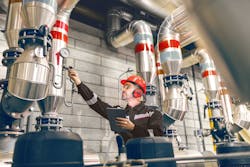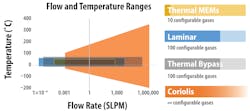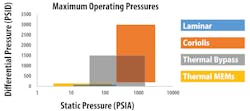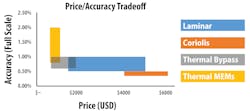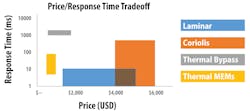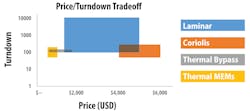10 parameters for choosing the optimal mass flowmeter for an application
With the broad selection of mass flowmeters on the market, finding one for an application can seem difficult, but understanding what to look for when comparing meters makes it easier. Primarily, flowmeters differ in the way they measure flow. A meter either measures flow directly or indirectly, and this measurement may or may not depend on fluid properties. For example, one meter calculates mass flow indirectly using a differential pressure measurement and known gas properties, while another meter calculates mass flow directly and independently of gas properties.
There is also considerable variation between the meters when it comes to fluid compatibility, operating range, measurement specifications and price. This article presents the basic operating principles of four common meter technologies and 10 parameters to consider when choosing the optimal flowmeter for an application.
Operating principles of common mass flow technologies
Coriolis flowmeters
Coriolis mass flowmeters utilize the Coriolis principle to measure mass flow directly and independently of fluid properties. These meters contain one or two tubes that are electromagnetically oscillated at the tube’s resonance frequency, and this oscillation is measured by sensors at different points along the length of the tube. When there is no flow, the tube oscillates symmetrically, and there is no phase difference between the points. As flow passes through, the tube twists, inducing a phase shift between the points that is directly proportional to the fluid mass flow rate. This measurement has no pressure dependence, and the only temperature effects are mechanical or electronic, resulting in zero shifts, which are an order of magnitude smaller than other technologies.
Laminar differential pressure flowmeters
Laminar mass flowmeters measure mass flow indirectly from differential pressure. These meters contain flow elements that convert turbulent flow into laminar flow. A sensor measures the pressure drop across these flow elements, and the meter uses this data along with the Poiseuille equation to calculate a volumetric flow rate. The meter then converts this volumetric measurement to standardized mass flow with the help of preloaded tables of gas properties that take temperature and pressure into account. Although there are several variables involved, high accuracy sensors ensure accurate readings. Since the mass flow calculation is different for each gas, it is important that the correct gas is selected.
Thermal flowmeters
There are two primary thermal flowmeter technologies, and each measures flow directly using temperature sensors. Additionally, thermal meter measurements depend on gas properties, which change with temperature, so they have gas tables loaded into them.
The first technology is the thermal bypass flowmeter, which operates by directing a small portion of the fluid to flow through a capillary tube wrapped in a heated element with temperature sensors on either side. When there is no flow, there is no temperature difference between the sensors. But the incoming cool flow passes the first sensor, and the temperature drops. The flow is then heated as it passes the heating element, and it raises the temperature of the second sensor. The temperature difference between the sensors is directly proportional to the flow.
The second technology is the thermal MEMS or CMOS flowmeter, which operates by maintaining a temperature differential across a heated sensor and a flow temperature sensor. When there is no flow, the differential temperature across the sensors is constant. A flow causes the flow temperature sensor to cool, and a heating current is added to compensate for the change. This current is directly proportional to the mass flow rate. The largest benefits of MEMS meters over thermal bypass meters are the speed of response and small package size.
10 parameters for choosing a mass flowmeter
- Flow rate
- Gas or gases used
- Temperature
- Operating pressure
- Pressure drop
- Price
- Accuracy
- Response time
- Warm-up time
- Stable measurement range (turndown)
Flow rate, gas choice and temperature
The Coriolis meter operates across the largest range of flow rates and temperatures, and it is a viable option for certain extreme high-flow, high-temperature applications. For extremely low-flow applications, the laminar and thermal bypass meters are better choices. In terms of gas compatibility, all meters work with common gases. But the Coriolis is the only meter compatible with some of the more difficult gases like NO2, which exists in equilibrium of unknown proportion with N2O4.
Operating pressure and pressure drop
Price/accuracy tradeoff
For some applications, high accuracy is not negotiable. Take for example an application where someone is working in a small-scale biopharmaceutical lab that plans to scale up for mass production and wants to minimize scaling up of inaccuracies. But in other applications, a lower accuracy meter will suffice, and this can save a lot of money.
Price/response time tradeoff
Laminar meters have the best response times in the middle range of flow rates. For extremely low flows, the laminar meter takes longer to detect small changes in differential pressure due to the large size of the flow body. For larger flows, the laminar meter software performs averaging to eliminate measurement noise, and this, too, slows response time.
Now, imagine working in a fiber optic cable manufacturing plant where there are typically multiple preforms being purified and multiple fibers being drawn at a single time, all off the same pressure source. During a long run, there may be several pressure dips and spikes caused by other runs stopping and starting, and these changes in pressure can cause delays and wasted batches. Fast response times here allow for pressure changes to be corrected quickly, minimizing wasted time and resources.
Price versus warm-up time
Price/turndown tradeoff
Conclusion
Selecting the mass flowmeter that is optimal for an application can seem complicated, but knowing what parameters are important to consider and in what order makes the decision much simpler. The choices can be narrowed significantly by first ensuring requirements for flow rate, temperature and gases are met. Then, take into account the reasonably adjustable parameters like operating pressure and pressure drop. After this, consider budget and application-specific parameters, such as accuracy, response time, warm-up time and turndown ratio. Armed with these guidelines, choosing the right mass flow solution based on the unique requirements of a given application should prove to be much simpler.
References
- 4800 Series Elastomer Sealed Thermal Mass Flow Controllers & Meters. (n.d.). Retrieved November 23, 2020, from https://www.brooksinstrument.com/en/products/mass-flow-controllers/ thermal-elastomer-sealed/4800-series.
- BASIS–OEM Gas Mass Flow Controllers. (2020, July 29). Retrieved November 23, 2020, from https://www.alicat.com/models/basis-oem-gas-mass-flow-controllers.
- CORI-FLOW. (n.d.). Retrieved November 23, 2020, from https://www.bronkhorst.com/en-us/products-en/liquid-flow/cori-flow.
- Coriolis Mass Flow Meters from 3/8. (n.d.). Retrieved November 23, 2020, from https://www.tacticalflowmeter.com/products/1-2-to-8-coriolis-mass-flow-meter.
- Coriolis Meters and Controllers. (2020, November 19). Retrieved November 23, 2020, from https://www.alicat.com/product/coriolis-mass-flow-meters-and-controllers.
- DPM mass flow meter. (n.d.). Retrieved November 23, 2020, from https://www.aalborg.com/index.php/main_page/product_overview/id_product_overview/88.
- FG-111B. (n.d.). Retrieved November 23, 2020, from https://www.bronkhorst.com/en-us/products-en/gas-flow/el-flow-prestige/fg-111b.
- GFM mass flow meter. (n.d.). Retrieved November 23, 2020, from https://www.aalborg.com/index.php/main_page/product_overview/id_product_overview/20/PHPSESSID/ 6fvllj6sapo9dscnrfd7l123m3.
- IQ FLOW. (n.d.). Retrieved November 23, 2020, from https://www.bronkhorst.com/en-us/products-en/gas-flow/iq-flow.
- 1Mass Flow Meters. (2020, December 08). Retrieved November 23, 2020, from https://www.alicat.com/product/mass-flow-meters.
- Proline Promass F 300Coriolis flowmeter. (n.d.). Retrieved November 23, 2020, from https://www.us.endress.com/en/field-instruments-overview/flow- measurement-product-overview/ Coriolis-flowmeter-Promass-F300.
- Quantim Series Coriolis Mass Flow Controllers & Meters. (n.d.). Retrieved November 23, 2020, from https://www.brooksinstrument.com/en/products/mass-flow-controllers/ coriolis/quantim.
- SLAMf Series Elastomer Sealed Thermal Mass Flow Controllers & Meters. (n.d.). Retrieved November 23, 2020, from https://www.brooksinstrument.com/en/products/mass-flow-controllers/thermal-elastomer-sealed/slamf-series.
- The Ultimate OEM / MFC Lifetime No-Drift Sensor Warranty. (n.d.). Retrieved November 23, 2020, from https://www.sierrainstruments.com/products/redy-smart.html.
